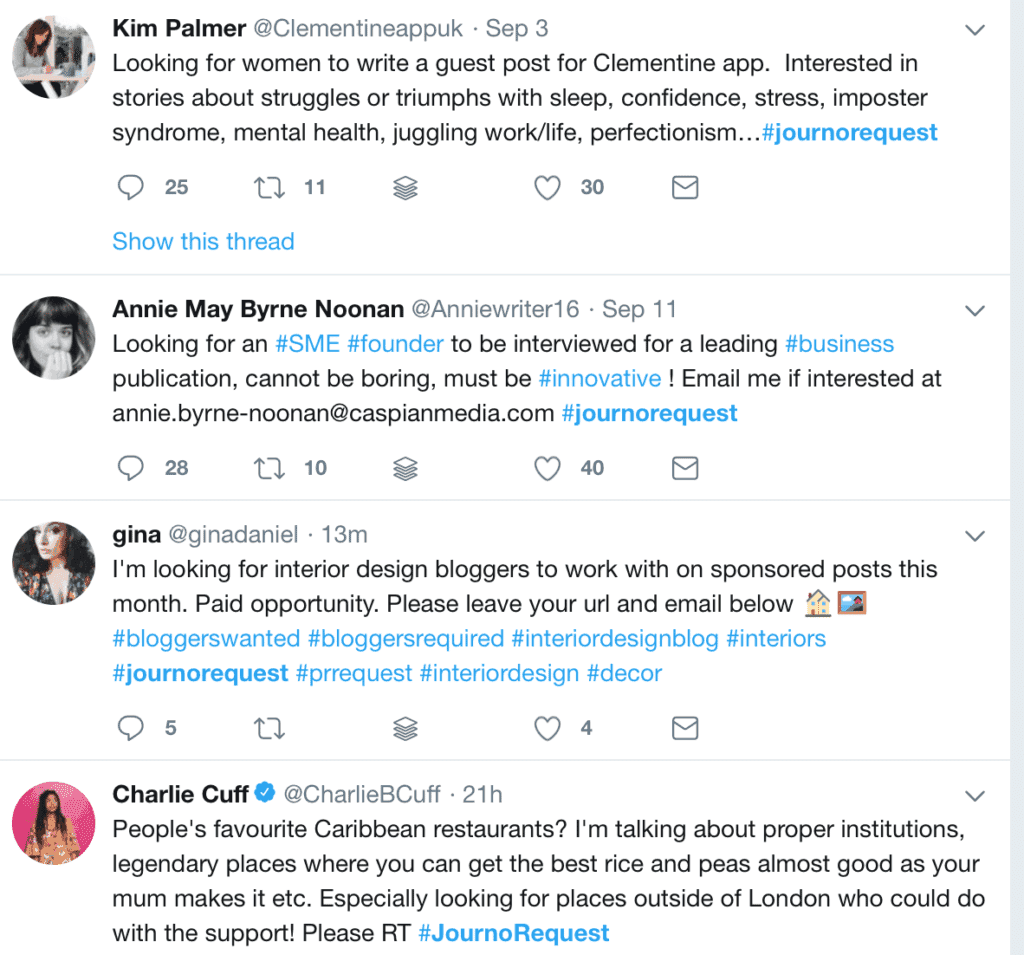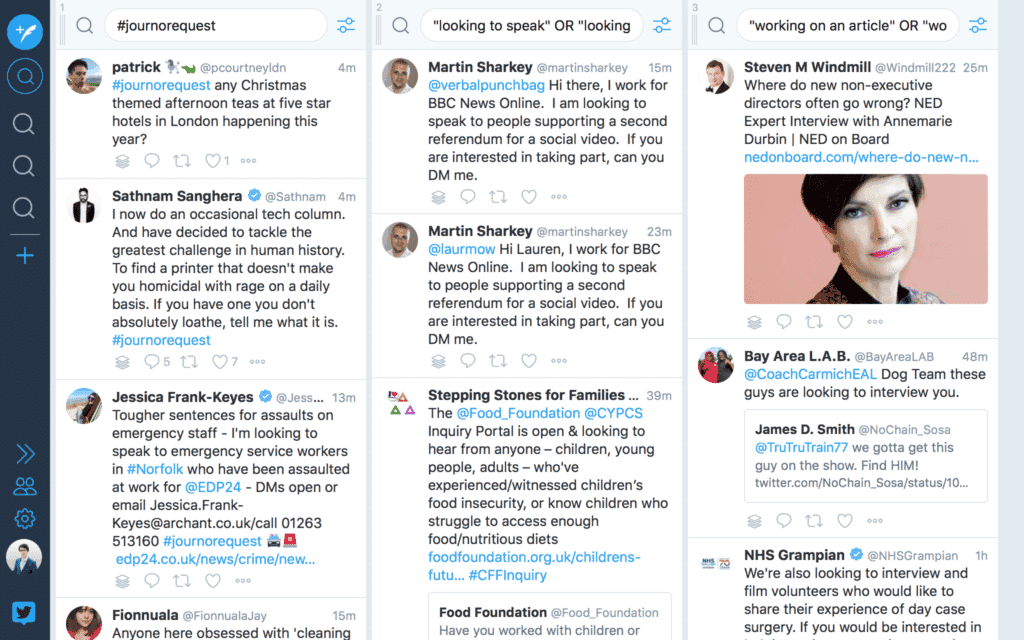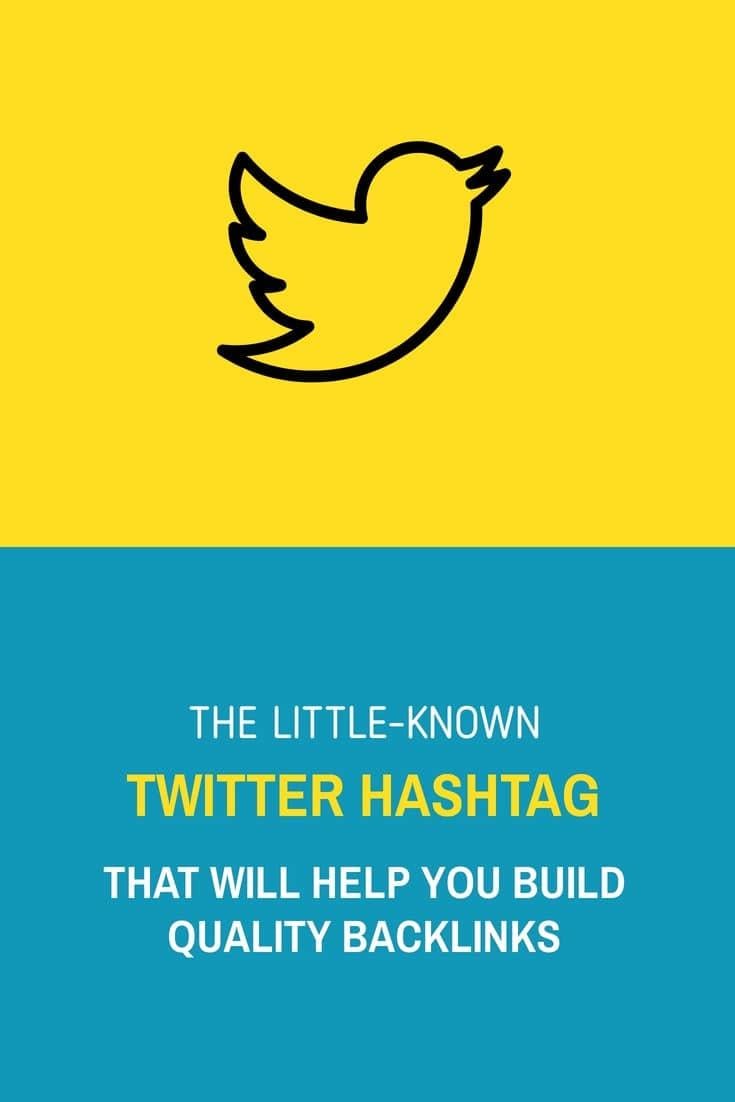If you have ever tried to do outreach to build backlinks, you know how frustrating the process can be.
You spend hours looking for the right people to reach out to, crafting your outreach emails and finally send them, already picturing yourself receiving a ton of quality backlinks in return.
And then.
Crickets.
That’s because in most cases, SEO outreach emails offer no value except for a weak “your readers may find my awesome article useful.”
If you want to build quality backlinks, you need to think beyond the backlink, ask yourself what’s in it for the person you reach out to and offer them something truly valuable.
That’s exactly what the journorequest hashtag helps you do.
What is the journorequest hashtag all about?
Every day, thousands of journalists and content writers look for sources for their upcoming articles.
Some of them will directly contact people they know or use HARO.
Some will simply post a tweet describing what they are looking for and use the #journorequest hashtag.

A few journorequests on Twitter.
If you have something to share, that’s a great opportunity for you to be genuinely helpful and build backlinks in the process.
With journorequest, backlinks become a byproduct of how valuable the information you provide journalists is.
Why use #journorequest and not HARO?
Now you may wonder, why should I use #journorequest instead of HARO (a popular website journalists use to find sources) or other services?
The main advantage of journorequest is that you get answers from journalists much more easily because there is a lot less competition.
According to HARO’s home page, there are 800,000+ sources using the service. This is great if you are a journalist but also means that getting the attention of the journalists you contact will be much harder so your message is way less likely to be seen.
Having used both HARO and journorequest, I see a clear difference. While most of my HARO messages went unanswered, the majority of my journorequests messages were promptly answered.
This said, using #journorequest is not a magic bullet and there are a few drawbacks:
- It’s mostly used by journalists in the UK. This means you will mostly get mentions and backlinks from UK websites. That’s not a big problem if you have a global audience but is far from ideal if you are a local business based in Ohio.
- There are fewer journalists using journoquest than HARO so you may have a hard time finding relevant requests if you are in a less popular niche.
- There is quite a lot of spam and irrelevant requests you will have to filter out.
- Some journalists will expect you to do all the work. A journalist once asked me to not only provide a valuable answer for her article but also to link out to it before she links out to me.
Don’t let these drawbacks scare you though! Journorequest is still valuable and can help you get quality backlinks from well-known publications.
For Matthew Rose, director of the London-based marketing agency Maade ,“answering journorequests led to a link and coverage in Forbes for Maade, links and features in the Independent and other leading sites for clients in the hospitality sector.”
Other Twitter hashtags you can use to find journalists and build backlinks
#journorequest is the main theme of this article because it’s the Twitter hashtag journalists and content writers seem to use the more but there are other hashtags you could use to build Twitter backlinks.
- #haro
- #prrequest
- #bloggerrequest
- #journorequests
What kind of journorequests can you expect to find?

There are sometimes hundreds of journorequests posted in a day so it’s important to know what to epect.
One of the drawbacks of journorequest is that there are way less requests than in HARO so you may have a hard time finding relevant requests if your industry isn’t well-represented.
That’s why I decided to follow Tim Soulo’s suggestion (thanks for the idea Tim) and count the number of requests per category.
To do this, I signed up for Journo Requests (a website sending a daily email with all genuine journorequests of the day) and counted the number of requests in each category over the course of a week.
- Entertainment (15 requests)
- Business and finance (41 request)
- Charity (99 request)
- Education (18 requests)
- Fashion and beauty (39 requests)
- Food and drink (30 requests)
- General (171 requests)
- Health and fitness (60 requests)
- Legal (15 requests)
- Lifestyle (24 requests)
- Parents and children (40 requests)
- Property (26 requests)
- Relationships (28 requests)
- Travel (39 requests)
- Tech (14 requests)
What are journalists using #journorequest looking for?
After counting the number of requests per category, I decided to go even further and analyze the typical profiles of journalists posting these requests.
At the end, I identified 3 main types of people using the journorequest hashtag.
#1 Bloggers looking for products to include in their gift guides and articles
A lot of lifestyle, food and beauty/fashion bloggers use the journorequest hashtag to find products to feature in upcoming gift guides and articles.
If you are a brand in the health, lifestyle, fashion, beauty or travel niche, this is an excellent opportunity to get your products mentioned on relevant blogs.
The downside is that most of these blogs are small to medium-sized. If you are looking for powerful backlinks from well-known publications, you are better off jumping to the next category.
#2 Journalists looking to quote experts
In addition to bloggers, a lot of journalists use the journorequest hashtag to find experts to quote in their articles.
While there are less requests from journalists than from bloggers,the reward is greater because journalists looking for expert advice tend to work for higher-profile publications such as Forbes.
#2 Journalists looking for people to talk about events they experienced
The last category of journalists I identified is journalists looking for individuals who suffer from a particular condition, belong to a particular group or experienced a specific event.
While this is a great way to spread the word about a condition you may be suffering from or talk about something that happened to you,, this is unlikely to be a good way to build backlinks because the resulting articles rarely include backlinks and you will often be mentioned as an example rather than featured as an expert.
A few traps to avoid
Using journorequest is an awesome way to get backlinks but there are a few traps to be aware of:
- Some tweets are not posted by journalists or content writers but by people simply asking for advice without any intention of ever quoting you in an article. An easy way to spot such tweets is simply to look at the bio of the person who posted the journorequest.
- Some websites ask for a backlink. Yes, they actually expect you to give them a quote and a backlink. This is harder to avoid but is rare enough not to be a real source of worry.
Then there are also cases when:
- The backlink will be nofollow and therefore less valuable for SEO.
- There will be no backlink at all
These are things you can’t predict or control so I wouldn’t worry about them but it’s good to know these are possibilities.
I personally answer as many relevant journorequests as possible knowing that a good percentage of my answers will turn into backlinks and that unlinked mentions are still valuable.
How to use the #Journorequest hashtag
Find journorequests you want to answer
Using the #journorequest hashtag is pretty straightforward.
Create a Twitter account if you don’t already have one, then simply head to this page and look for requests you would like to answer.
These can be journorequests that are directly related to your niche or simply requests you feel qualified to answer.
For example, I regularly answer questions about marketing and copywriting even though my main website French Together is a language learning blog. This helps me build quality backlinks while offering valuable advice.
Once you have identified a journorequest you can answer, ask yourself the following questions:
- Do I have something unique to share? I don’t bother answering unless I know my answer is actually helpful and unique.
- Is the journalist going to mention me or my website and link to it? Journalists rarely mention backlinks but looking at articles they published in the past is a good way to see whether they regularly link out to other websites or not.
- Are the links in the articles they publish dofollow? More and more websites nofollow external backlinks which greatly reduces their value (in addition to being unfair to people who take the time to contribute.)
- Is it worth the effort? A journalist once asked me if I would be willing to take part in a video. This didn’t make sense for me at the time because it was to answer questions about a topic that wasn’t directly related to my niche and being interviewed on TV about it, while cool, wouldn’t really help me.
How to answer a journorequest
If you answered yes to all the questions above, you are now ready to answer your first journorequest.
I’m not a PR expert so I’m not going to share stealth ninja secrets you can use to make every journalist want to talk about you.
I’m simply going to share my experience answering journorequests and what I think make the process successful.
Here is the process I follow:
- Carefully read the tweet. This is essential to make sure you don’t forget something and actually follow the instructions (e.g: send an email not a DM)
- Give a short and clear answer. I always ask myself: what can I write that will make the person reading curious and eager to learn more? I could send longer messages, of course, but I prefer to start with a short summary and let the journalist tell me exactly what they would like more detail on.
- Let the journalist know you would be happy to give more details. Often, the journalist finds my message interesting and asks me to write about a particular aspect in more detail.
- Be patient. In my experience, weeks (or even months) can go by before an article is published. In some cases, the article never gets published or the journalist decides not to use my story. In lots of cases, they do mention me and link to me but don’t tell me about it so I only find out much later.
How to find hidden journorequests

Using TweetDeck is a great way to have a quick overview of the latest tweets from journalists.
The journorequest hashtag is a great way to build backlinks but there are also a lot of journalists and bloggers who look for sources but don’t use the journorequest hashtag.
If you can find these tweets and be one of the first to answer them, you have even better chances of getting featured than with journorequest because there is less competition.
This is a more advanced opportunity and I recommend you to start by using the Journorequest hashtag first. You may find that it’s all you need to regularly get quality backlinks.
Once you have used Journorequest to the fullest, I highly recommend you to check out Detailed, Glen Allsopp’s new SEO website.
Glen is the person who discovered this “hidden journorequest” technique and I can’t imagine a better person to learn it from.
Have you had any success with the journorequest hashtag? Any tip you would like to share?
